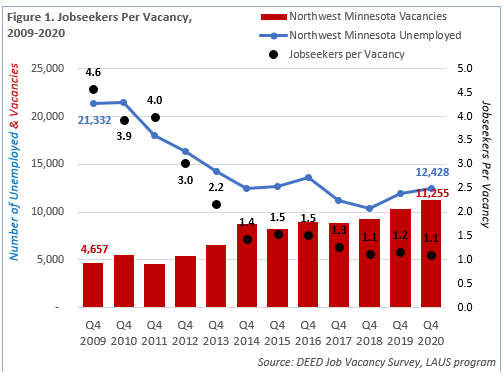 The presence of such industry powerhouses as Polaris, Arctic Cat and New Flyer make Northwest Minnesota a hub of transportation equipment manufacturing.
The presence of such industry powerhouses as Polaris, Arctic Cat and New Flyer make Northwest Minnesota a hub of transportation equipment manufacturing.
From wheat and potatoes to soybeans and sugar beets, the region is a major producer and processor of food staples and specialty agricultural products.
Want the freshest data delivered by email? Subscribe to our regional newsletters.
6/8/2021 9:00:00 AM
Erik White
As the regional economy continues to return to normal following the pandemic recession, employers in Northwest Minnesota are in hiring mode again but they're finding a tight labor market. DEED's Job Vacancy Survey from the fourth quarter of 2020 showed 11,255 job openings in the region, which is the fourth highest number on record. When compared to the count of unemployed workers from DEED's Local Area Unemployment Statistics, the region has already returned to a nearly 1-to-1 jobseeker to job vacancy ratio, essentially identical to pre-pandemic times.
This is a very different labor market scenario than what we saw during and following the Great Recession, when there were over 4.5 workers for every job vacancy. Things were tough for workers in 2009 as the number of unemployed climbed steadily and remained high due to widespread job loss, while the number of available jobs dropped below 5,000 and hovered around there for the next three years (see Figure 1).

Coming out of the current pandemic recession, with record high levels of demand, employers are looking for workers and often struggling to find them for a variety of reasons. This article from DEED shows that it is more than an issue of simple supply and demand. The authors suggest that employers may need to try more proactive outreach and outbound engagement to find the workers they need. This can include contacting their local CareerForce location, posting their jobs on MinnesotaWorks.net, creating employee referral programs, and reaching out to new populations.
According to the fourth quarter Job Vacancy Survey results for Northwest Minnesota, the industries that have the most current openings in the region include:
Together, these five industries account for nearly 85% of all the vacancies posted in the region. With the exception of Manufacturing, many of these industries are offering a lot of part-time work, and the majority of them are offering wages at or below $15 per hour. In addition, only 58% of all vacancies in the region are offering health insurance benefits, including only 13% in Accommodation & Food Services and 16% in Educational Services, which may be preventing workers from jumping into those jobs. In contrast, just over 75% of job postings in Retail Trade are now offering health insurance, a sign that those employers are willing to offer new benefits to attract more workers.
Contact Erik White.